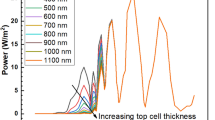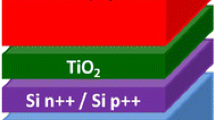Abstract
Shockley Queisser’s theory states that the efficiency of single-junction solar cells is restricted. This constraint can be avoided by employing a tandem (stacking multiple cells) setup. Furthermore, stacking layers such as Perovskite/silicon in tandem architecture might boost efficiency. In this research, SCAPD-1D was used to simulate a monolithic 2T Perovskite/silicon tandem solar cell. The tandem configuration is composed of a narrow bandgap (1.1 eV) crystalline silicon Heterojunction with an intrinsic thin layer (HIT) solar cell at the bottom and a wide bandgap (1.8 eV) lead-free Perovskite (Cs2AgBi0.75Sb0.25Br6) solar cell on top. The proposed tandem device is simulated as a standalone and integrated structure. The PCE of the calibrated standalone cell is 14.54% (top cell) and 21.66% (bottom cell), respectively. The calibrated cells are used to design an integrated tandem configuration. The current matching condition is accomplished at varied thicknesses of top and bottom absorber layers. A bottom cell's ideal current matching thickness is 230 µm, while a perovskite top cell is 550 nm. The overall conversion efficiency of the tandem device is 26%, with an FF of 79.18%.










Similar content being viewed by others
References
Taguchi M, Suzuki A, Ueoka N and Oku T 2019 Effects of poly(methyl methacrylate) addition to perovskite photovoltaic devices. AIP Conf. Proc., vol. 2067
Szabó L 2017 The history of using solar energy. Proc. - 2017 Int. Conf. Mod. Power Syst. MPS 2017, no. June 2017
Fraas LM 2014 Low-cost solar electric power. Low-Cost Sol. Electr. Power, 9783319075(June 2014) 1–181
Monteiro Albuquerque G 2018 Theoretical limit for efficiency of silicon solar cells. J. Appl. Phys.
Jimeno J C, Gutierrez R and Fano V 2016 A 3 Terminal Parallel Connected Silicon Tandem Solar Cell. Energy Procedia 92: 644–651
Akhil S, Akash S and Pasha A 2021 Review on perovskite silicon tandem solar cells: Status and prospects 2T, 3T and 4T for real world conditions. Mater. Des. 211: 110138
Rhodes C J 2014 Perovskites and their potential use in solar energy applications. Sci. Prog. 97(3): 279–287
Ansari M I H, Qurashi A and Nazeeruddin M K 2018 Frontiers, opportunities, and challenges in perovskite solar cells: A critical review. J. Photochem. Photobiol. C Photochem. Rev. 35: 1–24
Madan J, Shivani Pandey R and Sharma R 2019 Device simulation of 17.3% efficient lead-free all-perovskite tandem solar cell. Sol. Energy 197: 212–221
Jamal M S, Shahahmadi S A and Chelvanathan P 2019 Effect of defect density and energy level mismatch on the performance of perovskite solar cells by numerical simulation. Optik (Stuttg) 182: 1204–1210
Mailoa J P, Bailie C D and Johlin E C 2015 A 2-terminal perovskite/silicon multijunction solar cell enabled by a silicon tunnel junction. Appl. Phys. Lett. 106(12)
Jeong J, Kim M, Seo J, Lu H, Ahlawat P, Mishra A, Yang Y, Hope M A, Eickemeyer F T, Kim M, Yoon Y J, Choi I W, Choi S J, Lee J H, Kim D S, Kim J Y, Gratzel M and Emsley L 2021 Pseudo-halide anion engineering for α-FAPbI3 perovskite solar cells. Nature 592(7854): 381–385
Cheng Y and Ding L 2021 Perovskite/Si tandem solar cells: Fundamentals, advances, challenges, and novel applications. SusMat 1(3): 324–344
Decock K, Khelifi S and Burgelman M 2011 Modelling multivalent defects in thin film solar cells. Thin Solid Films 519(21): 7481–7484
Dahlal Z, Hamdache F, Rached D and Rahal W L 2021 Deep Impact of the n-c-Si Defect Density on Heterojunction with Intrinsic Thin Layer Solar Cells. J. Nano- Electron. Phys. 13(6): 1–4
Astakhov O, Smirnov V, Carius R, Petrusenko Y, Borysenko V and Finger F 2014 Relationship between absorber layer defect density and performance of a-Si: H and μc-Si: H solar cells studied over a wide range of defect densities generated by 2 MeV electron bombardment. Sol. Energy Mater. Sol. Cells 129: 17–31
Dubey S, Mathur A S and N and Singh B, 2019 Effect of defect density in different layers and ambient temperature of n-i-p a-Si single junction solar cells performance. Int. J. Sci. Res. Phys. Appl. Sci. 7(2): 93–98
Ouslimane T, Et-taya L, Elmaimouni L and Benami A 2021 Impact of absorber layer thickness, defect density, and operating temperature on the performance of MAPbI3 solar cells based on ZnO electron transporting material. Heliyon 7(3): e06379
Zekry A, Shaker A and Salem M 2018 Solar Cells and Arrays: Principles, Analysis, and Design. Advances in Renewable Energies and Power Technologies 1
Mandadapu U, Vedanayakam S V, Thyagarajan K, Reddy M R and Babu B J 2017 Design and simulation of high efficiency tin halide perovskite solar cell. Int. J. Renew. Energy Res. 7(4): 1604–1612
Chouhan A S, Jasti N P and Avasthi S 2018 Effect of interface defect density on performance of perovskite solar cell: Correlation of simulation and experiment. Mater. Lett. 221: 150–153
Paquin F, Rivnay J, Salleo A, Stingelin N and Silva C 2015 Multi-phase semicrystalline microstructures drive exciton dissociation in neat plastic semiconductors. J. Mater. Chem. C 3: 10715–10722
Qiu Z, Xu Z, Li N, Zhou N, Chen Y, Wan X, Liu J, Hao X, Bi P, Chen Q, Cao B and Zhou H 2018 Monolithic perovskite/Si tandem solar cells exceeding 22% efficiency via optimizing top cell absorber. Nano Energy 53: 798–807
Bett A J, Schulze P S C, Winkler K M, Kabakli W O, Ketterer I, Mundt L E, Reichmuth K, Siefer G, Cojocaru L, Tutsch L, Bivour M, Hermle M, Glunz S W and Goldschmidt J C 2020 Two-terminal Perovskite silicon tandem solar cells with a high-Bandgap Perovskite absorber enabling voltages over 1.8 V. Prog. Photovoltaics Res. Appl. 28(2): 99–110
Shrivastav N, Madan J, Pandey R and Shalan A E 2021 Investigations aimed at producing 33% efficient perovskite-silicon tandem solar cells through device simulations. RSC Adv. 11(59): 37366–37374
Burgelman M, Nollet P and Degrave S 2000 Modelling polycrystalline semiconductor solar cells. Thin Solid Films 361: 527–532
Mouchou R T, Jen T C, Laseinde O T and Ukoba K O 2021 Numerical simulation and optimization of p-NiO/n-TiO2 solar cell system using SCAPS. Mater. Today Proc. 38: 835–841
Mazumder S and Senthilkumar K 2022 Device study and optimisation of CZTS/ZnS based solar cell with CuI hole transport layer for different conduction band offset. Sol. Energy 237: 414–431
Lee S W, Bae S, Hwang J K, Lee W, Lee S, Hyun J Y, Cho K, Kim S, Heinz F D, Choi S B, Choi D, Yang J, Jeong S, Park S J, Schubert M C, Glunz S, Kim W M, Kang Y and Lee H S 2020 Perovskites fabricated on textured silicon surfaces for tandem solar cells. Commun. Chem. 3(1): 1–11
Husainat A, Ali W, Cofie P, Attia J and Fuller J 2019 Simulation and Analysis of Methylammonium Lead Iodide (CH3NH3PbI3) Perovskite Solar Cell with Au Contact Using SCAPS 1D Simulator. Am. J. Opt. Photonics 7(2): 33
Olyaeefar B, Ahmadi-Kandjani S and Asgari A 2017 Bulk and interface recombination in planar lead halide perovskite solar cells: A Drift-Diffusion study. Phys. E Low-Dimensional Syst. Nanostructures 94: 118–122
Siekmann J, Ravishankar S and Kirchartz T 2021 Apparent Defect Densities in Halide Perovskite Thin Films and Single Crystals. ACS Energy Lett. 6(9): 3244–3325
Madan J, Singh K and Pandey R 2021 Comprehensive device simulation of 23.36% efficient two-terminal perovskite-PbS CQD tandem solar cell for low-cost applications. Sci. Rep. 11(1): 1–13
Meyer E, Mutukwa D, Zingwe N and Taziwa R 2018 Lead-free halide double perovskites: A review of the structural, optical, and stability properties as well as their viability to replace lead halide perovskites. Metals (Basel) 8(9)
Chaudhary N, Chaudhary R, Kesari J P, Aa Patra and Chand S 2015 Copper thiocyanate (CuSCN): an efficient solution-processable hole transporting layer in organic solar cells. J. Mater. Chem. C 3(45): 11886–11892
Köhler M, Pomaska M, Procel P, Santhergen R, Zamchiy A, Lambertz A, Duan W, Cao P, Klingebiel B, Li S, Eberst A, Luysberg M, Qiu K, Isabella O, Finger F, Kirchartz T, Rau U and Ding K 2021 A silicon carbide-based highly transparent passivating contact for crystalline silicon solar cells approaching efficiencies of 24%. Nat. Energy 6(5): 529–537
Furube A, Yoshinaga T, Kanehara M, Eguchi M and Teranishi T 2012 Electric-field enhancement inducing near-infrared two-photon absorption in an indium-tin oxide nanoparticle film. Angew. Chemie - Int. Ed. 51(11): 2640–2642
Pandey R, Singla A, Madan J, Sharma R and Chaujar R 2019, Toward the design of monolithic 23.1% efficient hysteresis and moisture free perovskite/c-Si HJ tandem solar cell: A numerical simulation study. J. Micromechanics Microengineering 29(6B)
Korte L, Albrecht S, Crossland E, Stannowski B, Snaith H J and Case C 2019 Infrared Light Management Using a Nanocrystalline Silicon Oxide Interlayer in Monolithic Perovskite/Silicon Heterojunction Tandem Solar Cells with Efficiency above 25%. Adv. Energy Mater. 9(14): 1–9
Madhavan V E, Zimmermann I, Baloch A A B, Manekkathodi A, Beaidi A, Tabet N and Nazeeruddin M K 2020 CuSCN as Hole Transport Material with 3D/2D Perovskite Solar Cells. ACS Appl. Energy Mater. 3(10): 114–121
Burdick J and Glatfelter T 1986 Spectral response and I-V measurements of tandem amorphous-silicon alloy solar cells. Sol. Cells 18(3–4): 301–314
Acknowledgements
We would like to thank Prof. Marc Burgelman from the Electronics and Information Systems (ELIS) department at the University of Gent in Belgium provided SCAPS-1D to the writers.
Author information
Authors and Affiliations
Corresponding author
Supplementary Information
Below is the link to the electronic supplementary material.
Rights and permissions
About this article
Cite this article
CHAUHAN, S., SINGH, R. Investigation of 2T Pb-free wide bandgap perovskite/c-Si tandem device through simulation by SCAPS-1D. Sādhanā 48, 40 (2023). https://doi.org/10.1007/s12046-023-02100-8
Received:
Revised:
Accepted:
Published:
DOI: https://doi.org/10.1007/s12046-023-02100-8




